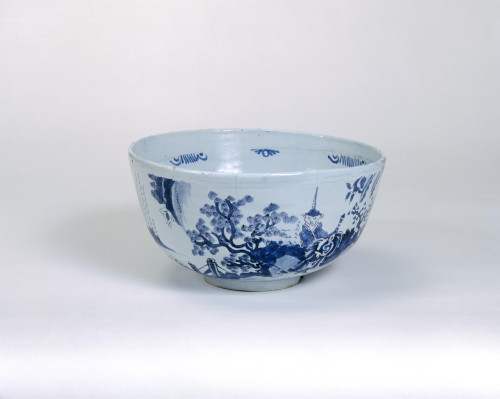12/1989
Collection
Ceramics
Brief description
Tin-glazed earthenware punch bowl hand-painted with figures in a watery landscape in blue and black, with bamboo and pine trees, possibly made in Brislington, Bristol and is thought to date from 1675-1700.
Object name
bowl
punch bowl
punch bowl
Object number
12/1989
Production date
c.1675-1700 (manufactured)
Production place
Bristol (manufactured)
Period
Stuart (1603-1714)
Material
tin glaze
earthenware
earthenware
Technique
glazed
hand painted
fired
hand painted
fired
Physical description
Tin-glazed earthenware punch bowl, painted in shades of blue and black with chinoiserie decoration of figures set in landscape with elaborate foliage. The landscape includes naturalistic renderings of pine trees and bamboo, and a scholarly figures in a watery landscape, with a rocky outcrop. Inside the bowl, towards the rim, are abstracted motifs. In the centre of the interior of the bowl is further decoration, with stylised flowers.
Dimensions
Diameter: 29.2cm
Height: 14.8cm
Height: 14.8cm
Website keywords
serving drink
Label
Label text for ‘New ways of living’ case, Information Bay 2, Geffrye Museum, 2010:
Punch bowl, about 1690
Tin-glazed earthenware, English
The secret of how to make porcelain was not known in England until the middle of the eighteenth century. Imitations of porcelain in blue and
white earthenware were made in Delft in the Netherlands and, like this punch bowl, in England. Both the English and the Dutch products became known as ‘delftware’. The clay used to make delftware was darker and coarser than that used for porcelain and because it was also softer, it was prone to chipping.
Label text for the exhibition At Home with the World, Geffrye Museum (20 March 2012- 9 September 2012):
Punch bowl, about 1690
Tin-glazed earthenware, England
As a 1750 riddle had it, why is a punch bowl like a playhouse? Because it is best when full… and this bowl would have been best full to the brim with the potent mixture punch. Originally from India, it was first drunk in England from around the 1650s.Punch combines a spirit – arrack from South Asia, rum from the West Indies or brandy from France – with water, lemon juice, sugar and spices.
Punch bowl, about 1690
Tin-glazed earthenware, English
The secret of how to make porcelain was not known in England until the middle of the eighteenth century. Imitations of porcelain in blue and
white earthenware were made in Delft in the Netherlands and, like this punch bowl, in England. Both the English and the Dutch products became known as ‘delftware’. The clay used to make delftware was darker and coarser than that used for porcelain and because it was also softer, it was prone to chipping.
Label text for the exhibition At Home with the World, Geffrye Museum (20 March 2012- 9 September 2012):
Punch bowl, about 1690
Tin-glazed earthenware, England
As a 1750 riddle had it, why is a punch bowl like a playhouse? Because it is best when full… and this bowl would have been best full to the brim with the potent mixture punch. Originally from India, it was first drunk in England from around the 1650s.Punch combines a spirit – arrack from South Asia, rum from the West Indies or brandy from France – with water, lemon juice, sugar and spices.








